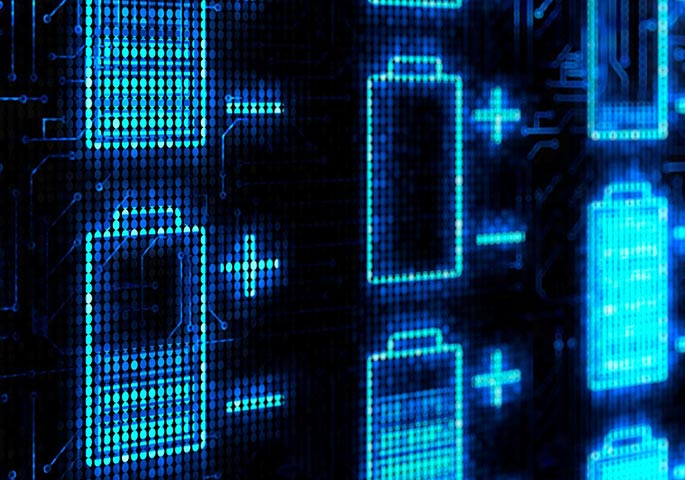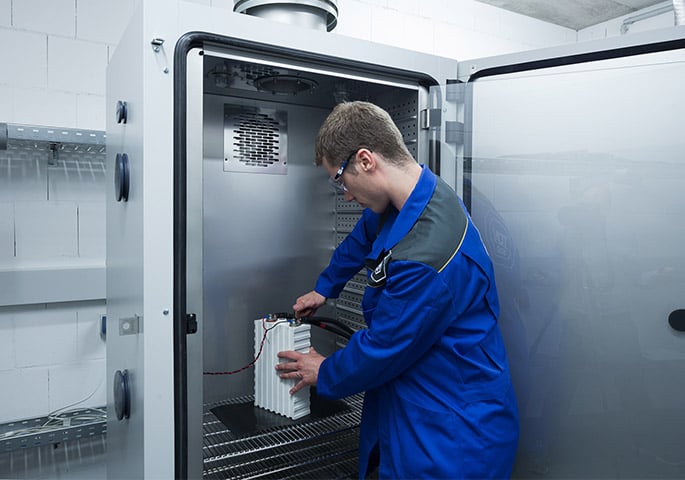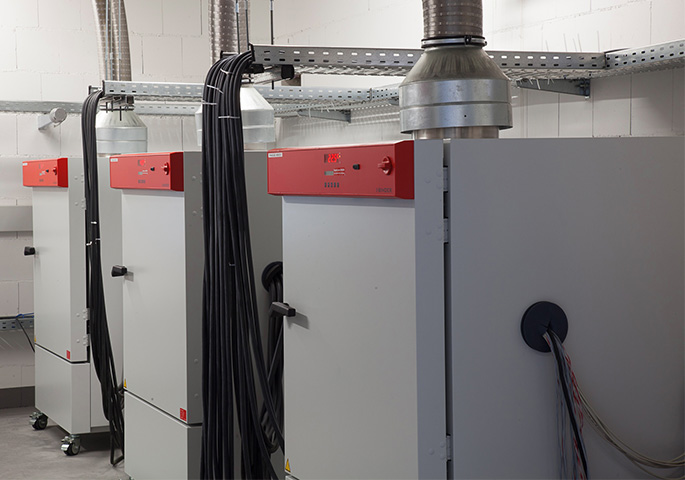Case Study TÜV SÜD
Tasks and objectives:
- Aging and performance tests on cells and modules for lithium-ion batteries
- Constant environmental conditions in the test room
- Special protective measures due to the risk of irreversible reactions
- Non-conductive racks for alternating temperature tests with pulsating current
BINDER solutions:
- BINDER environmental simulation chamber from the MKF series for complex dynamic climate profiles with vapor pressure humidification and drift-free capacitive humidity sensor for very accurate test results
- BINDER cooling incubator from the KB series with forced convection
- APT.line climate technology for homogeneous climate conditions throughout test objects
- Special coating on the racks
- Heated pressure relief valves
- Protective chains in the event of explosion

TÜV SÜD uses cell and module test chambers from BINDER to subject cells and modules to extreme aging and performance tests
Lithium-ion batteries play a central role in the efficient storage of electrical energy. Due to their high energy density at a relatively low weight, they have long been the battery of choice for stationary storage of renewable energies, but also in the area of automotive applications or electromobility. Due to their high storage capacity, they are used in ever increasing areas. But their high energy and power density means new potential hazards when operated outside their specifications. In addition, it is important to achieve the longest possible service life at consistently high capacity.
Aging and performance tests on cells and modules for lithium batteries
As a leading technical service company, TÜV SÜD subjects individual battery components to extreme endurance tests to determine the service life and performance of individual cells and modules for batteries under changing conditions. Cells and modules for lithium-ion batteries are tested for automotive applications or for the consumer sector. The temperature resistance of the cells and modules is tested and endurance analyses are carried out in various temperature ranges in environmental simulation chambers or cooling incubators from BINDER. The endurance tests are used to characterize the cyclic and chronological aging of components, as well as their aging under varying environmental conditions. A target value between 70% and 80% of the service capacity is often used. De-energized components are exposed to varying temperatures to test their service life (standard safety package A), which simulates cyclical and chronological aging. The unit is equipped with a second fixed independent adjustable temperature safety device, which turns the test chamber off when it reaches the factory preset temperature of 120 °C in order to protect it
against excessive heating. The controller, which is limited to a temperature of 120 °C, supports this safety measure.
Alternating temperature testing with pulsating current Extensive performance tests are carried out in order to
determine the performance of the cells and modules (safety package P). The components are therefore brought to the limits of their performance and load capacities by exposing them to constantly changing temperatures, with and without a current. The test object is exposed, for example, to temperatures of -10 °C to 55 °C in the cooling incubator under continuous temperature changes. Test scenarios are also carried out in the environmental simulation chamber in climatic ranges of -30 °C to 60 °C at up to 96% RH. The duration of the tests varies. Some tests last several months with
extreme demands on the material. Other tests require years with lower demands.
Special coating and heated pressure relief valve: Customization of environmental simulation chambers and cooling incubators
For the test runs, it is important that the test object is stored on an electrically non-conductive surface. For this reason, the stainless-steel racks have been specially coated to prevent transmission of an electrical charge. Access ports with silicone plugs have been specially installed on the walls of the units to ensure safe and simple cable feed through. In addition, special precautions are required. Due to the aging and other electrical characterization tests with cells and modules, in a worst-case scenario it is possible for gas to form in the test chamber as a result of irreversible reactions of cell components. For this reason, additional equipment has been installed on the side of the housings to feed through protective chains to prevent doors from blasting off in the event of an unforeseen explosion. To divert the gas or related pressure if necessary, pressure relief valves have been installed in the chambers. These re also heated to prevent the formation of condensate and possible icing.
Width instead of depth and extreme unit reliability
Lisa Döbler and Johannes Rößner, both test engineers at TÜV Süd Battery Testing GmbH, explain why they have opted for BINDER units: "To perform the experiments, constant environmental conditions in the test area are very important. The climate chambers from BINDER are known for their high reliability," explains Lisa Döbler about the demands on the test equipment. Both engineers also appreciate that the unit chambers are customizable. "The most compelling feature for us, however, is the ability to customize the units. We have been able to tailor the climate chambers to our specific needs," continues Johannes Rößner.


Advantages:
- Technology offering maximum reliability
- User-friendly chamber interior
- Comprehensive standard equipment
- "Made in Germany" quality
Areas of application:
- Plastics industry
- Automotive
- Electronics / Semiconductor Industry